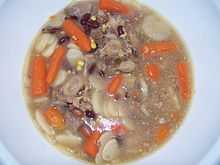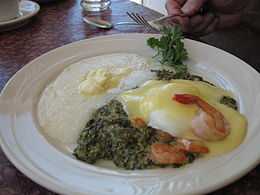Louisiana Creole cuisine


Louisiana Creole cuisine is a style of cooking originating in Louisiana, United States which blends French, Spanish, Portuguese, Italian, Native American, and African influences,[1] as well as general Southern cuisine. It is similar to Cajun cuisine in ingredients (such as the holy trinity), but the important distinction is that Cajun cuisine arose from the more rustic, provincial French cooking adapted by the Acadians to Louisiana ingredients, whereas the cooking of the Louisiana Creoles tended more toward classical European styles adapted to local foodstuffs. Broadly speaking, the French influence in Cajun cuisine is descended from various French Provincial cuisines of the peasantry, while Creole cuisine evolved in the homes of well-to-do aristocrats, or those who imitated their lifestyle. Although the Creole cuisine is closely identified with New Orleans culture today, much of it evolved in the country plantation estates so beloved of the pre-Civil War Creoles.[2] (Despite its aristocratic French roots, Creole cuisine does not include Garde Manger or other extremely lavish styles of the Classical Paris cuisine.)
Overview
The Portuguese, Spanish, Italian, and Canarian influences on Creole cuisine were in the heat of the peppers, the wide usage of citrus juice marinades, the supreme importance of rice, and the introduction of beans. The Portuguese, Spaniards and the Italians also used tomatoes extensively, which had not been a frequent ingredient in the earlier French era. Pasta and tomato sauces arrived during the period when New Orleans was a popular destination for Italian settlers (roughly, 1815 to 1925). Many of them became grocers, bakers, cheese makers and orchard farmers, and so influenced the Creole cuisine in New Orleans and its suburbs. The African influences which were extensive, came about because many of the servants were African-American, as were many of the cooks in restaurants and cafes.
The first French, Spanish and Portuguese Creole cookbooks date back to the era before the Louisiana Purchase. The first Creole cookbook in English was La Cuisine Creole: A Collection of Culinary Recipes, From Leading Chefs and Noted Creole Housewives, Who Have Made New Orleans Famous For Its Cuisine, written by Lafcadio Hearn and published in 1885.[3]
By that time Creole was already an identifiable regional cuisine recognized outside Louisiana: for example, an 1882 Florida hotel menu now in the New York Public Library's collection offered "Chicken Saute, á la Creole."[4]
Starting in the 1980s, Cajun cuisine began influencing New Orleans Creole cuisine, spurred by the popular restaurant of Chef Paul Prudhomme, a Cajun from Opelousas, Louisiana. A national interest in Cajun cooking developed, and many tourists went to New Orleans expecting to find Cajun food there (being unaware that the city was culturally and geographically separate from Acadiana), so entrepreneurs opened or rebranded restaurants to meet this demand. The "New New Orleans Cooking" of celebrity chef Emeril Lagasse includes both Cajun and Creole dishes. In his writings and TV shows, Lagasse both draws the distinction between Cajun and Creole and explains where they overlap.[5]
With the rise of southern American Cooking in the 1980s, a New Creole (sometimes called Nouvelle Creole or Neo-American Creole Fusion) strain began to emerge. This movement is characterized in part by a renewed emphasis on fresh ingredients and lighter preparations, and in part by an outreach to other culinary traditions, including Cajun, Southern, Southwestern, and to a lesser degree Southeast Asian. While the Cajun food craze eventually passed, Modern Creole has remained as a predominant force in most major New Orleans restaurants.
Classic dishes
Appetizers

- Crabmeat Ravigote
- Oysters Bienville
- Oysters en brochette
- Oysters Rockefeller
- Shrimp remoulade
Soups

- Crawfish Bisque
- Gumbo
- Oyster and Artichoke Bisque
- Yakamein
- Turtle soup
- Oxtail soup
Main dishes

- Blackened Salmon
- Chicken Creole
- Creole Baked Chicken
- Crawfish étouffée
- Crawfish Fettuccine
- Jambalaya
- Mirliton
- Pompano en Papillote
- Potato Salad
- Quiche
- Red beans and rice
- Rice and gravy
- Sauce Piquante
- Shrimp Bisque
- Shrimp Creole
- Smothered Pork Chops/Steak
- Stuffed Bell Peppers
- Trout meunière
Side dishes
- Maque choux
- Red beans
- Dirty rice
- Green Beans w/Potatoes
Desserts

- Bananas Foster
- Bread pudding
- Beignets
- Creole cream cheese ice cream
- King cake
- Doberge cake
- Pralines
- Pecan pie
- Banana pudding
- Peach Cobbler
- Blackberry Cobbler
Beverages
- Café Brûlot
- Café au lait
- Ramos Gin Fizz
- Sazerac cocktail
Breakfast

- Calas
- Eggs Sardou
- Grits and Grillades
- French toast (Pain perdu)
Condiments
See also
| This article is part of the series |
| American cuisine |
|---|
|
Regional cuisines Northeastern
Other |
|
Ingredients
|
|
Styles
|
|
Ethnic and cultural
|
|
Holidays and festivals
|
|
|
New Orleans restaurants
- Antoine's
- Cochon
- Arnaud's
- Galatoire's
- Brennan's
- Commander's Palace
- Dooky Chase's
- Hubig's New Orleans Style Pies
References
- ↑ Beggs, Cindy, Gipson, Bridget, Shaw, Sherrie. "Cajun and Creole Cuisine." University of West Florida. Accessed July 2011.
- ↑ George Washington Cable, The Creoles of Louisiana, Pelican Press, ISBN 1-56554-752-7
- ↑ The full text and page images can be found at Feeding America: The Historic American Cookbook Project.
- ↑ "Windsor Hotel" restaurant (Jacksonville, Florida) menu dated January 5, 1882, item: "Chicken Saute, á la Creole"
- ↑ Emeril Lagasse, Emeril's NEW New Orleans Cooking, William Morrow, ISBN 0-688-11284-6
External links
- The full text and page images of Lafcadio Hearn's La Cuisine Creole can be found here at Feeding America: The Historic American Cookbook Project.
- The full text and page images of Célestine Eustis's Cooking in Old Creole Days can be found here at Feeding America: The Historic American Cookbook Project.
| ||||||||||||||